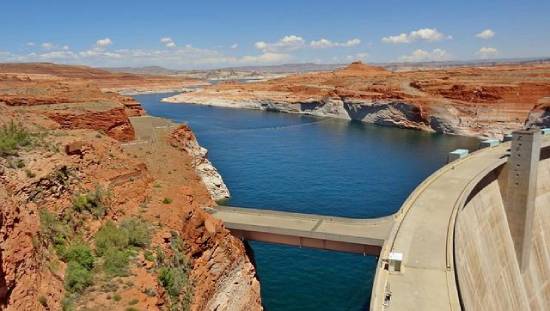The second-largest reservoir in the U.S. dropped to a historic low on Tuesday as a climate-fueled megadrought continues in the nation’s West. Lake Powell, which sits on the border of Utah and Arizona, fell below 3,525 feet for the first time since the reservoir was filled more than 50 years ago to create the Glen Canyon Dam, AP News reported.
There are now concerns about the dam’s ability to continue generating energy in the near future as the water levels drop faster than anticipated.
“We clearly weren’t sufficiently prepared for the need to move this quickly,” John Fleck, who directs the University of New Mexico’s Water Resources Program, told AP News.
The Western U.S. is in the midst of its worst megadrought in 1,200 years, and the climate crisis has made the drought 42 percent more extreme than it would have been otherwise. So far, most of the concerns surrounding the drought have revolved around the supply of water to California, Nevada and Arizona, AP News explained. However, the situation at Lake Powell reveals that hydroelectric power is now also at risk.
The Glen Canyon Dam provides power to around 5 million customers in Arizona, Colorado, Nebraska, Nevada, New Mexico, Utah and Wyoming. Currently, water levels at Lake Powell are 35 feet above the point at which turbines would stop moving, otherwise known as “minimum power pool.”
The 3,525-foot level is considered a “target elevation” for drought contingency plans, according to CNN. The U.S. Bureau of Reclamation predicted in early March that the water would fall to that level sometime between March 10 and 16. That the target has ultimately been breached is cause for alarm, experts said.
“We’re talking about the second-largest reservoir ever constructed by the United States,” National Oceanic and Atmospheric Administration Drought Task Force co-leader and Dartmouth assistant professor Justin Mankin told Yahoo Finance. “The thing is like 200 miles long when it’s full. It’s held back by one of the largest concrete structures ever built by humans, the Glen Canyon Dam. So the idea that this massive structure, which I think is pretty emblematic of America’s best-ever effort to kind of transform water supply in the American West… is failing is really putting us in uncharted territory, legally and politically and socially, economically.”
Lake Powell’s troubles reflect the broader impact of the megadrought on the entire Colorado River system. The river supplies more than 40 million people in seven Western states as well as Mexico, according to CNN. It also supplies Lake Mead, the nation’s largest reservoir, which powers the Hoover Dam. Lake Mead’s water levels fell to unprecedented lows in August of 2021, prompting the federal government to declare a water shortage for the Colorado River for the first time. By 2021, California, Colorado, New Mexico, Utah, Arizona, and the Navajo Nation had all declared drought states of emergency, Yahoo News reported.
In the immediate future, federal officials believe that snow melt will restore Lake Powell in the coming months.
“Spring runoff will resolve the deficit in the short term,” Wayne Pullan, regional director for the U.S. Bureau of Reclamation, told AP News. “However, our work is not done.”
In the longer term, the region has to rethink how it uses its water supply as the climate crisis continues.
“[W]hat we’re seeing is the beginning or some point in the process of what is going to be a really long and painful collapse of the Western water economy as we know it,” Mankin told Yahoo Finance.




